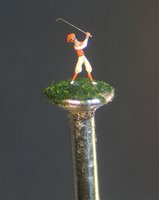Monday, October 27, 2008
Aaaaawwwwww....Puppy Cam
Posted by Brian Borden at 6:12 PM 0 comments
Labels: Entertainment, Humorous, Interesting, Nature
Tuesday, October 21, 2008
Big League Little League Game
How would you like to of had a turnout like this for one of your Little League games?
Improv Everywhere made a bunch of kids' day with this one!!!
Posted by Brian Borden at 1:28 AM 0 comments
Labels: Interesting
Friday, September 05, 2008
Ms. Dewey

Ok so I decided to finally do a new post and as I was going over old post ideas from a year ago I came across "Ms. Dewey." Ms. Dewey is an interactive search engine by Microsoft, www.msdewey.com. As I am looking at the website I have the TV show Stargate Atlantis playing in the background. While watching I notice one of the guest stars on the episode and she looks an awful lot like Ms. Dewey! Upon a little investigation I find out its the actress Janina Gavankar and sure enough she also plays Ms. Dewey. What are the odds. Anyway, check out the site. Its a little diversion.
Posted by Brian Borden at 10:59 PM 0 comments
Labels: Interesting, Links, Microsoft
Wednesday, April 18, 2007
The 20 Greatest Historical Myths
Here is a Top 20 list by Noivedya Juddery from the Humanities Talks website. Only #6 and #1 would I pose any gripe with. Still a few are quite interesting.
It is said that those who don't know history are condemned to repeat it - and as any history buff can tell you, much of history is something you would NOT want to repeat. However, many well-known historical "facts" are myths, with no basis in fact. Here (and in the next few segments) are 20 of the most common, which have misled and misinformed people for years, decades, or centuries.
If more people knew the facts, a few of the great history-makers would be recognised (anyone heard of Ub Iwerks?), some famous people would stop taking so much credit, and we would stop blaming apples for everything! Let's start with the following misconceptions...
20. Eve ate a bad apple
An apple a day might keep the doctor away, but they have still had bad publicity as the "forbidden fruit" that Eve tasted in the Garden of Eden, thereby making life difficult for all of us. Yet nowhere in the biblical story of Adam and Eve is an apple mentioned. It is simply called "the fruit of the tree that is in the middle of the garden" (Genesis 3:3). OK, it COULD have been an apple, but it might just as well have been an apricot, a mango, or any other sort of fruit.
19. Newton was hit by an apple
Apples continued to get bad press with the famous story that scientist Sir Isaac Newton was under a tree, minding his own
business, when an apple fell on his head. Just as well it provided him the inspiration for the laws of gravity, or the poor
apple would never be forgiven! But while the falling apple is a good story, it probably never happened. The story was first published in an essay by Voltaire, long after Newton's death. Before that, Newton's niece, Catherine Conduitt, was the only person who ever told the story. It was almost certainly an invention.
18. Walt Disney drew Mickey Mouse
One of the world's most famous fictitious characters, Mickey Mouse, is credited to Walt Disney. However, Mickey was the vision of Disney's number one animator, Ub Iwerks. Disney, never a great artist, would always have trouble drawing the character who made him famous. Fortunately for him, Iwerks was known as the fastest animator in the business. He single-handedly animated Mickey's first short film, Plane Crazy (1928), in only two weeks. (That's 700 drawings a day.) But give some credit to Disney - when sound films began later that year, he played Mickey's voice.
17. Marie Antoinette said "Let them each cake"
In 1766, Jean Jacques Rousseau wrote of an incident he recalled from some 25 years earlier, in which "a great princess" (name unknown) was told that the country people had no bread. "Then let them eat cake," she replied. When Rousseau wrote of this, Marie Antoinette was an 11-year-old child in Austria. The French Revolution would not begin for another 23 years. The myth that she spoke these infamous words was probably spread by revolutionary propagandists, to illustrate her cold indifference to the plight of the French people.
In the next chapter of this list, we uncover a tall tale about Napoleon, and find out how witches did NOT die, whatever you might have heard...
16. The Great Train Robbery was the first feature film
When it was released in 1903, "The Great Train Robbery" pioneered several techniques, includes jump cuts, medium close-ups and a complex storyline. But the first feature film? It was only ten minutes long! Even most short films are longer than that. The first feature-length film was a 100-minute Australian film, "The Story of the Kelly Gang", released three years later. Even if you think of a feature film as the "feature" of a cinema program, the title would go to one of a number of French films made during the 1890s (but I won't name one, as that could cause any number of arguments).
15. Van Gogh sliced off his ear
Van Gogh is known as the archetypal starving artist, only selling one painting in his lifetime, and - in a quarrel with Gauguin - slicing off his ear, not long before committing suicide. Though he did face a tragic end, and his own paintings sold poorly, it is worth noting that he spent most of his life teaching and dealing art. He only spent eight years of his life painting, which helps to explain why he didn't starve to death. Also, he didn't slice off his entire ear, just a portion of his left lobe. Painful, but not nearly as bad as you might have thought.
14. Witches were burned at stake in Salem
The Salem (Massachusetts) witch trials of 1692 led to the arrests of 150 people, of whom 31 were tried and 20 were executed. But just as these trials were based on ignorance, there are many misconceptions about them. For starters, the 31 condemned "witches" were not all women. Six of them were men. Also, they were not burned at stake. As any witch-hunter would know, a true witch could never be killed by this method. Hanging was the usual method - though one was crushed to death under heavy stones.
13. Napoleon was a little corporal
Some people believe that Napoleon's domineering ambitions were to compensate for being so physically small. Not so. True, Napoleon was called Le Petit Corporal ("The Little Corporal"), but he was 5 feet, 7 inches tall - taller than the average eighteenth-century Frenchman. So why the nickname? Early in his military career, soldiers used it to mock his relatively low rank. The name stuck, even as he became ruler of France.
12. King John signed the Magna Carta
The Magna Carta (Great Charter) is known as a landmark in history, limiting the power of the King of England and sowing the seeds of democracy. Paintings show King John reluctantly signing the Magna Carta in a meadow at Runnymede in 1215. Fair enough, except for one thing. As well as being a rogue, John was probably illiterate. As anyone could see from looking at one of the four original Magna Cartas in existence, he simply provided the royal seal. No signature required.
11. Walter Raleigh introduced potatoes and tobacco to England
Sir Walter Raleigh - explorer, courtier, privateer - Is one of greatest myth figures ever to come from England. Virtually every reason for his fame is untrue. Was he handsome? According to written accounts, he was no oil painting - though somehow he charmed Queen Elizabeth I, and had a reputation as a ladies' man. Did he lay his cloak across a puddle so that the Queen could step on it? No, that was pure fiction. Most importantly, he didn't return from his visit to the New World (America) with England's first potatoes and tobacco. Though Raleigh is said to have introduced potatoes in 1586, they were first grown in Italy in 1585, and quickly spread throughout Europe (even across the English Channel). Also, though people all over Europe blame Sir Walter for their cigarette addictions, Jean Nicot (for whom nicotine is named) introduced tobacco to France in 1560. Tobacco spread to England from France, not the New World.
10. Magellan circumnavigated the world
Everyone knows two things about Portuguese explorer Ferdinand Magellan. One, he was the first man to circumnavigate the world; and two, during this historic trip, he was killed by natives in the Philippines. Of course, those two things tend to contradict each other. Magellan only made it half-way around the world, leaving it to his second-in-command, Juan Sebastian Elcano, to complete the circumnavigation.
9. Nero fiddled while Rome burned
We all know the story of mad Emperor Nero starting the Great Fire of Rome in 64 AD, then fiddling while the city burned. However, this would have been impossible. For one thing, the violin wouldn't be invented for another 1,600 years. OK, some versions of the story suggest that he played a lute or a lyre - but then, scholars place the emperor in his villa at Antium, 30 miles away, when the fire began. Though he was innocent of this disaster, however, there is much evidence to show that he was ruthless and depraved.
8. Captain Cook discovered Australia
Many Australians will agree that this isn't so - but for the wrong reasons. They will point out that, many years before Cook arrived in Sydney in 1770, Australia had already been visited by Dutchmen Abel Tasman and Dirk Hartog, and an English buccaneer, William Dampier. Of course, it had been previously been discovered some 50,000 years earlier by the indigenous Australians.
But in fairness to Cook, he did discover a new part of the country - and more importantly, this led to the first white settlers (an opportunity that Tasman, Hartog and Dampier didn't take). So let's say that Cook DID discover Australia! Fine, but Cook was actually a Lieutenant when he sailed to the Great South Land. The "captain" rank might be a minor point, but it's certainly inaccurate - and as he is called "Captain Cook" so often that it might as well be his name, it's one worth correcting.
7. Shakespeare wrote the story of Hamlet
William Shakespeare is generally known as the greatest playwright who ever lived, even though most of his plays were not original, but adaptations of earlier stories. "The Tragedy of Hamlet, Prince of Denmark" (1603), probably his most famous play, was based on an ancient Scandinavian story. But while it might not have been the original version of the story, we can safely assume it was the best.
6. America became independent on July 4, 1776
Hold the fireworks! As most American school children (and many non-American ones) are aware, America's founding fathers signed the Declaration of Independence on July 4, 1776. However, the war raged for another seven years before independence from England was finally granted on September 3, 1783. On that day, Britain's George III and US leaders signed the Definitive Treaty of Peace.
5. Edison invented the electric light
Thomas Edison is known as the world's greatest inventor. His record output - 1,093 patents - still amazes us, over a century later. Astonishing, except for one thing: he didn't invent most of them. Most Edison inventions were the work of his unsung technicians - and his most famous invention, the electric light, didn't even belong to his laboratory. Four decades before Edison was born, English scientist Sir Humphry Davy invented arc lighting (using a carbon filament). For many years, numerous innovators would improve on Davy's model. The only problem: none could glow for more than twelve hours before the filament broke. The achievement of Edison's lab was to find the right filament that would burn for days on end. A major achievement, but not the first.
4. Columbus proved that the Earth was round
It was American author Washington Irving, some 500 years after Columbus sailed to America, who first portrayed the Italian explorer as launching on his voyage to prove that the Earth was round, defying the common, flat-earther belief of the time. In fact, most educated Europeans in Columbus's day knew that the world was round. Since the fourth century BC, almost nobody has believed that the Earth is flat. Even if that wasn't the case, Columbus would never have set out to prove that the Earth was round... simply because he didn't believe it himself! Columbus thought that the Earth was pear-shaped. He set sail to prove something else: that Asia was much closer than anyone thought. Even in this, he was wrong. To further besmirch his memory, it should also be noted that he never set foot on mainland America. The closest he came was the Bahamas. Pear-shaped, indeed!
3. Gandhi liberated India
To westerners, Mahatma Gandhi is easily the most famous leader of India's independence movement. He deserves credit for promoting the ancient ideals of ahimsa (non-violence). However, most historians agree that Indian independence was inevitable. Gandhi was just one of several independence leaders. The Indian National Congress was founded as early as 1885, when he was only 16. Gandhi's much-publicised civil disobedience was only a small part in the movement, and some historians even suggest that India would have achieved independence sooner if they had focused on the more forceful methods that they had used 50 years earlier, and which were still advocated by other independence leaders, such as Gandhi's rival Netaji Chandra Bose (who is also revered in India).
2. Jesus was born on December 25
Christmas is meant to celebrate the birth of Jesus, but there is no evidence whatsoever, biblical or otherwise, that He was actually born on that day. Nor is there anything to suggest that He was born in a manger, or that there were three wise men (although, as any nativity play will remind you, three gifts were mentioned). There are differing views as to why December 25 was chosen as Christmas day, but one of the most interesting is that the day was already celebrated by followers of Mithras, the central god of a Hellenistic cult that developed in the Eastern Mediterranean around 100 BC. The followers of this faith believed that Mithras was born of a virgin on 25 December, and that his birth was attended by shepherds...
Which brings us to the number one historical myth - something that is drilled into the heads of nearly all American schoolchildren...
1. George Washington was America's first President
Everyone "knows" that Washington was the first of the (so far) 43 Presidents of the US. However, this isn't strictly the case. During the American Revolution, the Continental Congress (or the 'United States in Congress Assembled') chose Peyton Randolph as the first President. Under Randolph, one of their first moves was to create the Continental Army (in defence against Britain), appointing General Washington as its commander. Randolph was succeeded in 1781 by John Hancock, who presided over independence from Great Britain (see myth #6). After Washington defeated the British at the Battle of Yorktown, Hancock sent him a note of congratulations. Washington's reply was addressed to "The President of the United States". Eight years later, as a revered war hero, Washington himself became America's first popularly elected President - but strictly speaking, the FIFTEENTH President!
Noivedya Juddery. Noivedya is a writer and journalist based in Australia. A member of the Sri Chinmoy Centre He can be contacted via his website: http://www.markjuddery.com/
Posted by Brian Borden at 8:03 PM 0 comments
Labels: History, Interesting, Lists, Myths
Thursday, February 08, 2007
Ice, Ice Baby
Cool pictures from the website www.agisbau.com of the aftermath of an ice storm in Versoix, Switzerland.














Posted by Brian Borden at 12:46 AM 1 comments
Labels: Interesting, Photography, Science
Wednesday, January 03, 2007
Tattoos to Go
Finally I can get a tattoo!
With tattoos being the rage a couple of years ago, I still was not tempted at all to get one. Not because I don't like them, some are very cool, but there is nothing that I could think of that I would like to display for the rest of my life. According to the article, 17% of those with tats are thinking of getting it removed. Think how often we get tired of a TV show, our cars, how our house is decorated, the style of music we listen to, and yet we want to showcase a picture for the decades of our life. I know several guys that have tats of their college fraternity somewhere on their body. It's 15 years later and they have nothing to do with the frat, don't see their "brothers", and really could care less about the tat. Unfortunately it's displayed every time they wear shorts. With easily removable tats, no more permanent mistakes. It would reflect who you are now not who you used to be. If this breakthrough holds true, look for a huge tattoo movement. Maybe I'll even get one...maybe a tiny one...OK maybe not...we'll see.
Removable Tattoos an Attractive Option
'Smart Pigment' Permanent, Yet Easily Removed With Laser
By APRIL ARMSTRONG, M.D.
ABC News Medical Unit
Thinking about removing that tattoo of your ex-girlfriend's name from your arm?
While lovers come and go, tattoos are intended to be permanent. But as more consumers get tattoos, there are also more people eager to get rid of them.
Roughly one in four adult Americans has at least one tattoo — and 17 percent are considering getting rid of theirs, according to a survey published in the September issue of the Journal of the American Academy of Dermatology.
Now, one company has found a way to make tattoo inks that, while still permanent, are also easily removed. The company, Freedom-2 LLC, will make the special ink available next year.
This new type of ink is injected into the skin in the same way as conventional tattoo inks. However, it is only permanent in the skin until the owner changes his or her mind. With a single pass of a laser, tattoos composed of this special ink can be safely and fully removed.
The new technology is the result of a combined effort by a team of scientists from Harvard Medical School and Duke University.
Removal of Conventional Tattoos Time-Consuming and Costly
Conventional tattoos are typically removed with laser technology. However, laser treatments are costly and time-consuming, and complete removal is sometimes not possible.
"Conventional tattoo removal takes multiple visits," said Dr. Charles Taylor, director of Khosrow Momtaz Phototherapy Center at Massachusetts General Hospital in Boston. "Professional tattoo artists use heavy metals in their tattoo inks. For example, blacks have iron, blues have cobalt. Heavy metals are fairly resistant to current laser technology."
And certain characteristics of the tattoo can also affect how difficult removal will be. Dr. Sandy Tsao, associate program director for procedural dermatology at Harvard Medical School in Boston, said the type of ink that is used, along with the age of the tattoo and the skill level of the artist involved, can play an important role.
"These three factors determine how many treatments the patient will require and the eventual cost," Tsao said. "On average, a professional tattoo requires about eight to ten sessions, spaced six to eight weeks apart. The average cost per treatment ranges from $250 to $400."
This means the tattoo that might have cost you a couple of hundred bucks to get will require a few thousand dollars to remove.
Aside from the time and money required for conventional tattoo removal, there are a number of well-known risks associated with the laser tattoo removal procedure itself.
"The treatments can be painful, and they generally require a topical anesthetic," said Tsao.
During the period immediately following laser tattoo removal, some of the expected side effects include scabbing and crusting, which can last between a week and ten days, Tsao said.
"The biggest risk is having a permanent loss of your normal pigmentation, almost similar to having a negative impression of the tattoo image on the skin," she said. "Tattoo removal can also lead to scar formation, sometimes.
"There is an increased possibility of scarring if the tattoo is located on the ankle or the upper back because these are scar-prone areas."
'Smart Pigment' Allows for Targeted Destruction
Unlike the conventional counterparts, the company says that its new ink is specifically designed to be removed by a laser.
The dyes come "packaged" in tiny beads called polymer microspheres. The beads are made of a material commonly used in the body in plastic and orthopedic surgery.
Each of these tiny beads contains a "target" pigment. When this target is hit by a laser, it explodes, rupturing the entire bead. The body will then absorb the nano-sized pigment particles and remnants of the beads, leaving no visible evidence of the tattoo behind.
"With this new tattoo ink, you have safety, reliability and removability," said Dr. Eric Bernstein, a member of the scientific advisory board of Freedom-2 and an associate professor of dermatology at University of Pennsylvania in Philadelphia. "Removal of Freedom-2 tattoos should take only one session, and it costs about one-tenth of that of conventional tattoo removal."
The first of these removable inks will hit the market in 2007. Initially, only black will be available, but developers say blue, red and yellow inks will not be far behind.
New Ink Offers Safe Option
The creators of the ink say it was developed with safety in mind. This could figure in big, as the tattoo industry in the United States is not regulated by any federal governing body and each state draws up its own guidelines on how to ensure consumer safety.
"In today's world, there's no regulation," Bernstein said. "You buy the tattoo ink, and you don't even know what's in it.
"It's completely unacceptable that [the tattoo ink] is something that is put in the body and we don't know what's in it."
Bernstein said some conventional tattoo inks contain toxic substances. The new tattoo ink, he said, is made of safe, biodegradable dyes.
"With more and more sophisticated consumers, they want to ask about whether a tattoo is sterile and safe," he said.
Removable Tattoo Ink Will Likely Appeal to Consumers
Safety aside, the new ink could be in high demand by those who wish to keep their options open. Some say it could even encourage consumers who previously may have never thought about getting body art to take a trip to the tattoo parlor.
"I am all for the development of tattoo ink particles that are long lasting in the skin, and the moment patients decide to have them removed, they can be removed immediately," Taylor said.
"Tattooing is a real art," said Tsao. "People change depending on their life circumstances and want to have the freedom to have tattoos removed. So it's appealing to have a tattoo ink that can be more easily removed."
"When people get tattoos now, they can't get into the military or get jobs," said Bernstein. "When you are young, you don't think about stuff like that. I'd be shocked if most of the people getting tattoos would not ask for removal tattoos.
"It's nice to be able to express yourself, do something wild and crazy and have the ability to undo it."
Posted by Brian Borden at 11:30 PM 0 comments
Labels: Interesting, Science
Sunday, December 31, 2006
3D Pavement Drawings
I love those 3D pavement drawings. If you haven't seen them before, they can be mind blowing. My favorite drawer is Julian Beever. Check out his website. Basically for a 3D drawing you have to assume a viewing from one perspective. If you view from the wrong angle it looks weird and distorted but from the right angle it takes on a 3D appearance. Here is an example or two great looking 3D pavement drawings:

Now here are the same drawings from the wrong angle:

Neat!
Here is my favorite by Julian Beever:
Posted by Brian Borden at 11:00 PM 0 comments
Labels: Interesting
Wednesday, December 13, 2006
Is it One or Two?
Posted by Brian Borden at 9:06 PM 0 comments
Labels: Entertainment, Interesting
Wednesday, December 06, 2006
Evel Knievel Stunt Cycle
On the Church @ Bellair blog Josh asked, "What is one of your all time favorite Christmas presents?" Mine was my Evel Knievel Stunt Cycle. Reminiscing about it led me to YouTube.com looking for videos of the "King of the Stunt Men" and wouldn't you know someone has done a video using that same toy stunt cycle. Ahhhh...the memories.
And for those of you who have no idea who Evel Knievel is...shame on you!
Check out the Wikipedia entry or watch the video. The video is from a special on the History channel. I wish the complete show was online but this video covers the Caesar's Palace fountain jump.
Posted by Brian Borden at 11:27 PM 1 comments
Labels: Entertainment, Interesting
Monday, December 04, 2006
F/A-18F Super Hornet Video
Awesome sound barrier cone at the beginning and then at about 2:20, the hornet seems to defy gravity. From the demo "Vapor Trails Video" filmed by Tom Vance, filmed on October 2005 at the California International Airshow 2005 in Salinas, California, USA.
Posted by Brian Borden at 3:39 PM 0 comments
Labels: Interesting
Sunday, December 03, 2006
Fungus Eats Man's Face
A man develops a rare infection by the parasitic Mucor Fungus. The result of such an infection is usually death. It is worse than the flesh eating virus. The infection was in his sinus cavity and to save his life he had to have both eyes, his nose, his sinus cavity and the upper portion of his mouth. I can't even comprehend such a decision having to be made.
Here's the video
Here's a video on the Mucor Fungus. It shows it infecting ants, killing them and then sprouting from their bodies.
Posted by Brian Borden at 11:22 PM 0 comments
Labels: Interesting, Science
Thursday, November 30, 2006
Criss Angel Shows You How to Levitate
Here is a little more complicated levitation trick explained by Criss Angel.
Posted by Brian Borden at 2:10 AM 0 comments
Labels: Interesting, Magic
One Way to "Magically" Levitate
Recently I had a discussion on how some magicians levitate. Here is one video showing the very basic "Balducci Levitation" trick explained.
Posted by Brian Borden at 1:37 AM 0 comments
Labels: Interesting, Magic
450GB of Data Can Now Be Stored on Paper
Amazing. Someone was definitely thinking out of the box. Now if we could just bring back punch cards!
M. A. Siraj, Arab News
BANGALORE, 18 November 2006 — Is it time to say goodbye to CDs, DVDs, Zip drives?
A Kerala student has developed a technique for portable data whereby the data can now be stored on ordinary paper. And to boot, larger amounts of data can be had on lesser space.
The immediate question that pops into the mind is how to retrieve the data. Will it be as easy as feeding a floppy disc or CD into the drive and having it on the monitor? Perhaps it will be much easier than that. The piece of paper or even plastic sheet storing the data has only to be scanned in the scanner and read over the monitor. So wait, scan drive would be part of your computer.
Named “Rainbow Technology”, the new technique is the brainchild of Sainul Abideen, who has just finished his MCA at Muslim Educational Society Engineering College in Kuttipuram in Kerala’s Malappuram district.
The extremely low-cost technology will drastically reduce the cost of storage and provide for high-speed storage as well. Files in any format such as movie files, songs, images and text can be stored using this technology.
Currently, of the several options available for data storage, DVDs are the best mode. But a high quality DVD, which is very expensive can store only about 4.7 gigabyte (GB) of data. In contrast, the Rainbow Versatile Disc (RVD) can store 90 to 450 GB. And Sainul has simultaneously developed a scanning drive based on his Rainbow software which will come in smaller sizes to be initially carried with the laptops and later to fit into their bodies.
Sainul says a CD or DVD consumes 16 grams of polycarbonate, a petroleum by-product. While a CD costs Rs.15 (SR1.25), his paper or plastic-made RVD will cost just about Rs.1.50 and has 131 times more storage capacity.
Sainul, who has just turned 24, says that instead of using zeroes and ones for computing, he used geometric shapes such as circles, squares and triangles for computing which combine with various colors and preserve the data in images. An RVD therefore looks like a printout of modern art.
He says all kinds of data has to be first converted into a common format called “Rainbow Format.”
In a demo at his college laboratory, this writer could see text typed on 432 pages of foolscap paper being stored in a four square inch paper. The writer was even shown a 45-second video clip of a Malayalam film stored on an ordinary paper. Sainul was guided by Prof. Hyderali, head of the MCA Department at the College in all these projects.
Sainul says the biggest advantage of the new technology will be the biodegradable nature of his storage devices which will do away with e-waste pollution.
He says with the popularity of his Rainbow Technology, computer or fashion magazines in future need not carry CDs in a pack.
The computable data printed on a paper can be attached in a tearable sheet and will be capable of carrying even software programs, or movies, MP3 data or text. Sainul is promoting the theme of disposable storage and says newspapers, magazines and video albums could benefit from the idea and also distribute their material in this form in order to curtail use of paper and facilitate the disposal of the waste.
Sainul is simultaneously molding the technology into “Rainbow Cards” which will be of SIM card size and store 5 GB of data equivalent to three films of DVD quality. Sainul says as “Rainbow Cards” will become popular, Rainbow Card Readers will replace CD drives of mobile phone and computer notebooks and will enable more data in portable forms for mini digital readers.
Large-scale manufacture of the Rainbow card will bring down its cost to only 50 paise (half a rupee). He is currently in consultation with a UK-based company for manufacture of the Rainbow Cards.
Sainul has also put forward the idea of databank with Rainbow Technology, which will enable huge servers with a high storage capacity.
Quoting a research study carried out in the US in 2003, he says the entire static data in the US would require $5 billion (Indian Rupees 230 billion) for storage with the current storage devices. But Rainbow based databank could reduce the cost to Rs.3.5 million. He says he could construct databank with almost 123.60 Peta Byte (PB) capacity.
Sainul is also working on project Xpressa, a software package for regional languages. This will enable the Internet browser to access the newspapers available on Internet through mobile phone in audible form.
Sainul Abideen can be contacted at: 0091-98950-81493, Res: 0091-494-2495493, email: mysainul@yahoo.com
Posted by Brian Borden at 12:55 AM 0 comments
Labels: Computer, Interesting
Tuesday, October 31, 2006
Sunday, October 29, 2006
Camel Caravan
Posted by Brian Borden at 1:17 PM 0 comments
Labels: Interesting
Art in Miniature


Check out a truly gifted craftsman. Willard Wigan sculpts in miniature and I do mean "mini," on the head of a pin, in the eye of a needle, in the point of a pencil, and even on a human hair. The patience he has is inspiring. His sculptures are so small that he can only carve in-between heartbeats so his hand isn't moving.
Check out his website.
Posted by Brian Borden at 1:07 PM 0 comments
Labels: Interesting
Worcester Wreath marks 2006 with expansion of the Arlington Wreath Project

Since 1992 Merrill Worcester, owner of Worcester Wreath, has provided Christmas wreaths for Arlington National Cemetery, over 5000 a year. I never knew this. Apparently each year groups of Maine school kids make a special trip to the cemetery to help out. This year Worcester is beginning to expand his project to include other state and national cemeteries. Its strange how such a little thing as placing a wreath on a tombstone can touch us so much. I think it forces us to once again remember the sacrifice some have given their country. Mr. Worcester seems to get it. Let's hope this inspires others.
Worcester Wreath marks 2006 with expansion of the Arlington Wreath Project
Our Mission: Remember - Honor - and Teach
Remember the fallen;
Honor those who serve;
Teach our children the value of freedom.
2006 will mark the 15th anniversary of holiday wreaths being sent from the State of Maine to Arlington National Cemetery. Each year the folks at Worcester Wreath Company make and decorate wreaths that will adorn over 5000 headstones of our Nation’s fallen heroes - in what has become an annual event coordinated with the Cemetery Administration and the Maine State Society.
Row after row of bleached white stones, with evergreen wreaths and red bows – it is a stirring image to commemorate those who made the ultimate sacrifice for our country.
What started over 15 years ago, as one's man's dream to honor Veterans with Maine wreaths for the holidays, has become an annual event cherished by many. Humbled with a new understanding about the impact the Arlington Wreath Project has made, not only in honoring the dead, but recognizing the sacrifices of the living, Morrill Worcester - President of Worcester Wreath Company committed himself to doing more, by reaching out across the country.
New in 2006!
Spurred by the tremendous outpouring of letters and interest, and to celebrate the 15 years of giving, Worcester Wreath Company solicited Civil Air Patrol and its members to help expand the reaches of the Arlington Wreath Project with Wreaths Across America – the placing of memorial wreaths during a special ceremony at each of the over 230 State and National Cemeteries, and Veterans Monuments across the country.
Morrill Worcester - President of Worcester Wreath Company explains his desire to develop the Wreaths Across America project:
"Our goal is to expand the recognition of those who serve our country, both past, present, and future, as well as their families who deserve our support. Without the sacrifices of our veterans, there would be no opportunity to enjoy the freedoms, the life we live today."
Worcester Wreath invites you to attend the annual wreath-laying at Arlington National Cemetery, or in your local area.
Thursday, December 14th, 2006 - More details coming soon!
The list of locations is growing each day and our goal with Civil Air Patrol is to involve every State and National cemetery, Veterans Monument and Memorial across the country.
Note: If you are not able to attend, please participate by taking a moment of silence at the noon hour on December 14th, to reflect on the sacrifices made and freely given, by those who will not be home for the holidays.
Posted by Brian Borden at 12:52 PM 0 comments
Labels: Interesting
Wednesday, October 18, 2006
Ask Ms. Dewey
Posted by Brian Borden at 10:15 PM 0 comments
Labels: Interesting
Friday, October 13, 2006
Neat video from AlbumLeaf
Time lapsed video set to music. I just thought it looked and sounded interesting.
Posted by Brian Borden at 6:08 PM 0 comments
Labels: Interesting







